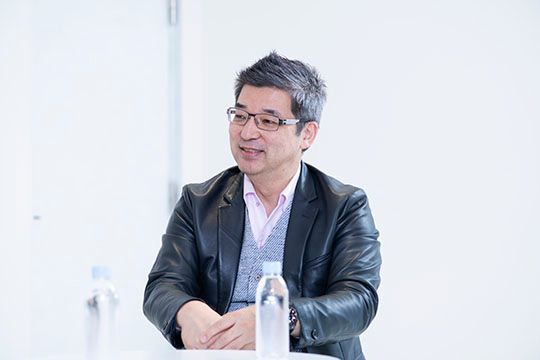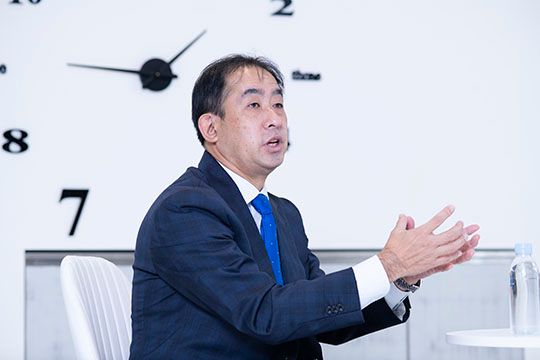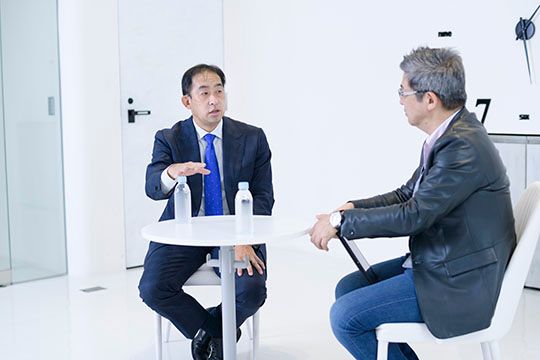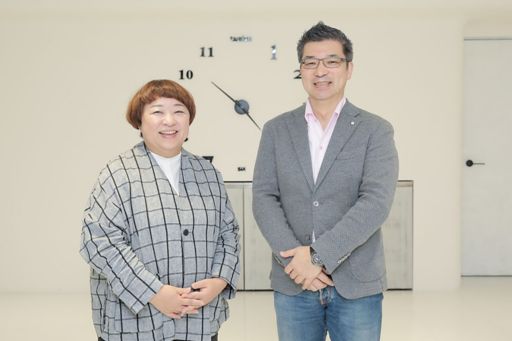Solutions to the issue of labor shortages due to the decline in the working population continue to be discussed in familiar fields centered on the services industry. However, the shortage of labor is now becoming an important discussion topic also in areas that are not closely associated with our daily lives such as enormous natural disasters and aging social infrastructure.
In these situations, one of the solutions that are being cited is the “drone.”
What is the real value that drones will bring to society? In this article, we will introduce the discussions conducted between Kohtaro Sabe of Aerosense Inc., which provides industrial solutions combining domestic-made autonomous unmanned aerial vehicles (UAVs) and cloud services, and Masayuki Chatani of KPMG Ignition Tokyo. During the discussion, they envision and fantasize about the role of "drones" in Japanese society in the post-COVID-19 era as well as 30 and 50 years from now while sorting out the current situation.
Change of Mindset from Entertainment Use to Industrial Use


(Kohtaro Sabe, President & CEO, Aerosense Inc. (left), Masayuki Chatani, Representative Director & CEO of KPMG Ignition Tokyo and CDO of KPMG Japan (right)) *Professional affiliation and official position in the article are at the time of publication.
Chatani: Many people became interested in drones this year because of the installation at the opening ceremony of the "Tokyo 2020 Olympics and Paralympics (held in 2021).” This is why I planned this dialogue with you to talk about the future of drones.
I heard that you were researching robot technology when you were working at Sony. When and how did you first become interested in drones?
Sabe: Like you just said, I was originally researching entertainment robots. Unfortunately, however, Sony temporarily withdrew from the robot sector and took the strategy of diverting its robotics technology to the development of AI and other technologies. This meant that I had to move to another area as well.
However, there was a feeling inside me that “I wanted to make a solid business out of robots once again.” At the time, when I was thinking vaguely about what kind of research I wanted to do, I participated in a meeting of researchers in an industry-government-academia collaboration.
At the meeting, they had been discussing for about two years the fact that in Japan, major companies were developing robots and had developed great technologies, but they had not been able to commercialize them, whereas in the U.S., start-up companies were developing robot technologies that could replace human work more robustly, such as tele-operation technologies. They were wondering what the difference was.
I then began to think of developing a robot that could do what humans cannot do, and considering that what humans cannot do is to fly, I began to think that I wanted to research flying robots, that is, drones. This was around 2010 to 2011.
Chatani: So it’s been about 10 years since then. I heard that you began to promote the drone business within Sony. When was this?
Sabe: In 2012, there was a reform of the research center and they decided to propose new businesses across the board by removing the boundaries of expertise. My team was developing AI software, but as a result of the reform, we were able to form a cross-functional team involving hardware and software, and an environment was prepared where we were able to plan and propose new businesses using drones.
At that time, drones were not as well known as they are today, and when I talked about drones, the response was, "Who would use such a thing?” However, around the third proposal, I switched to a proposal suggesting that the drone should be used for industrial purposes, to which the response was, "That may be a possibility." This is how we were finally able to start a drone development project to create a new business.
Process of Achieving Industrial Drones
Chatani: In the early 2010s, the number of people who had seen an actual drone was probably still a minority even among people who were associated with technology. I remember that the timing was such that drones were finally beginning to be sold and people with an eye for new things were thinking, "This looks kind of interesting.”
After you started to promote the use of drones, I feel that the use of drones became less associated with entertainment and more "industrial," as you mentioned earlier. They are now used for civil engineering and construction surveys, etc. Can you tell us about this transition?
Sabe: Like you just said, drones were originally positioned as an extension of consumer cameras and were intended to be owned and enjoyed by individuals.


In contrast, I became aware of "drones for industrial use" after I learned about the Sasago Tunnel ceiling collapse accident, which occurred on December 2, 2012.
It is a known fact that, at the time, there was a great deal of noise about “the infrastructure crisis” and while the importance of inspection work was pointed out, there were concerns about work costs and labor shortages. The idea of utilizing drones was proposed to solve these issues but they could not be tested immediately due to restrictions such as the Radio Act and the Civil Aeronautics Act. Therefore, the government added a special drone zone to the National Strategic Special Zone, which is one of the deregulation and institutional reform plans.
Chatani: So that was the background behind the use of drones in the industrial field in Japan. Were Aerosense providing VTOL (Vertical Take Off and Landing) drones at that time?
Sabe: The development of VTOL drones was initiated based on the idea of Hisashi Taniguchi, President of ZMP Inc.
We had originally developed our own multicopter drones, but in order to differentiate our drones from others, it was more desirable for them to be able to hover like a multicopter drone during takeoff and landing, but also to be able to fly horizontally like an airplane. We therefore decided to create a new drone with such "weapons (features).”
Chatani: As the shape of a multicopter drone and that of a VTOL drone is quite different and the propulsion mechanism is also different, I imagine that the flight experiments were very difficult.
Sabe: Yes. It has been about five years since the company was founded, but it took us about five years to be able to sell what we had worked on at the beginning. We were making prototypes and breaking them repeatedly.
Chatani: Since this Aerosense drone is more like an airplane than a helicopter, I suppose the design and calculations that need to be made are completely different. There must have been a lot of hard work involved in the production process.
Source of Competitiveness of Aerosense's Industrial Drones


Chatani: I now understand that Aerosense’s products are made with various knowledge and connections.
Now, can you tell us about the features of Aerosense’s products, such as Aerobo Wing (VTOL fixed-wing drone), Aerobo (self-flying drone for surveying), and Aerobo on Air (wired power-feeding drone)?
Sabe: First of all, "Aerobo Wing" can be described as an airplane-type drone. Its speed is faster than the normal multicopter drone and it can fly at 70 km/hour. It can also fly over a wide area without worrying about flight range limitations, which had been the issue with conventional multicopters.
Its speed is 70 km/h, which is its cruising speed. It is energy efficient and can fly for as long as 40 minutes at that speed, allowing it to fly over a much larger area with a flight range of 50 km compared to multicopters. It can also carry a payload of up to 1 kg. (Reference video: external link)
"Aerobo on Air" is a type of drone that is powered by a cable from the ground. It is connected with a single cable composed of optical fiber and a power line. As power can be supplied all the time, it is intended for use at video production sites, such as for shooting events from the sky for long periods of time.
The use of drones is also becoming popular at music festivals and in the production of TV programs. However, most drones can actually fly for only about 20 minutes, which means that the shooting will be interrupted when the batteries run out. As this means that the schedule will not be kept as planned, I believe that "drones that can keep flying" will be very useful.
Chatani: I presume that the optical fiber and electric cable used for "Aerobo on Air," for instance, is probably not commercially available. Are the peripherals made in-house?
Sabe: Yes, we are using a composite cable developed by a cable manufacturer specifically for Aerosense drones. Furthermore, the equipment that winds the cable (Japanese) is also made in-house. As an optical fiber is delicate and has a specific angle at which it can be bent, unlike fishing lines and power cables, we had no choice but to prepare it ourselves.
Chatani: I thought so. I was surprised and was wondering whether the idea of not just assembling existing parts was your culture from the time you were developing robots?"
There were members who were saying, “After all, as software codes and data are open-sourced, we now live in a world where we can just assemble them and make 'many things ourselves without having to create them from scratch.’ For example, Python is a high-level programming language but as the functions are already prepared, you can create software as if you are making quick meals.
This means that once the parts to assemble the product are available, it will be possible to "make it without having to know the inner workings.” The current distribution system which makes this possible is really amazing.
At the same time, people may be becoming reluctant to create hardware and peripherals on their own because it’s difficult and time-consuming.
Sabe: That's true. Also, as the manufacturing industry is moving quite fast, we will lose market competitiveness if we don’t use what is available. Therefore, Aerosense of course makes use of existing technologies. However, we also believe that searching for "something" that does not exist in the world or that has not yet been released to the world and creating it ourselves will also become a source of competition.
China is very strong in the drone industry and there are many different modular components that are available. Even if we made something in that layer, we would be competing on price. Rather, I think that the source of competition will be to make things that are not made overseas and do things that they cannot do.
Drones and Civil Engineering/Construction Fields Have High Affinity
Chatani: What kind of camera does the "Aerobo on Air" use?
Sabe: It uses a 4K camera with a 30x zoom including a 20x optical zoom. While the range of motion is limited, the drone can be expected to capture images at far distances with high resolution. (Reference video: external link)
Chatani: Can it be used for surveying as well?
Sabe: "Aerobo" (self-flying drones for surveying) would be better suited to aerial surveying. They can fly autonomously and also zigzag within a specified area.
We can accurately reproduce a construction site by taking a huge number of photos, uploading them to the "Aerobo Cloud" and converting them to three dimensions.


When we actually use it, a GPS "Aerobo Marker" with an accuracy of less than 1 cm can be placed on the ground, and it can be used as a landmark for combining and processing images. As the measurement accuracy has an error level of within 5 cm for the entire model, I think it is sufficient for use.
For instance, if you want to measure an area the size of an elementary school playground, you may not even need 10 minutes to do the work.
Chatani: It’s amazing that you don't even need 10 minutes. But afterward, I think you need to do some post-processing to apply full-screen filters and effects to the image buffer of the camera with which you took the picture, before displaying the images on the screen.
Sabe: That’s right. But even including that process, the work can be completed in about an hour. As construction sites are a little larger than school playgrounds, zigzag flights are required more frequently to ensure greater accuracy, and the work time increases accordingly. However, the images can be confirmed at the morning meeting of the next day if not earlier.
Chatani: What kinds of people make use of such images?
Sabe: Land surveyors and construction companies. Conventionally, surveyors used to triangulate and make drawings, but there is a limit to how much they can survey in a day's time. Now, the survey can be completed several times or dozens of times faster by utilizing drones.
Chatani: Surveying a golf course, for example, is quite extensive and I think drones would be useful in such situations.
Sabe: Yes. We have had requests from golf course management companies, and there are many cases of surveys carried out by customers using our solutions.
Recently, there have been cases of golf courses being converted to mega solar power plants, and we are receiving an increasing number of inquiries because they require surveying. It seems that they need to think about the direction for installing the solar panels and also fly a drone periodically for inspection to see if there is any damage.
There are other applications for wired drones in the construction field. For instance, at construction sites, the ground is leveled unmanned via remote control. However, when the operator tries to operate using the cameras in the cockpit, it is difficult to see what is going on in the front, back, left, and right of the area, which can cause accidents. Therefore, information from the camera of the wired drone can be sent to support the operator (Japanese). (Reference video: external link)
In many cases, construction work using such methods is usually done in remote areas or near volcanoes. As there is no communication infrastructure in these areas, there are cases where a wired drone is flown to serve as a simple base station.
Profile of Interviewee


Kohtaro Sabe
President & CEO, Aerosense Inc.
Kohtaro Sabe joined Sony Corporation in 1996 after graduating from the Department of Electrical Engineering, Graduate School of Engineering, the University of Tokyo. He was involved in the commercialization of the first-generation AIBO and the development of humanoid robot, QRIO. After engaging in fundamental research on robot intelligence, he led the development of intelligent Sony product lineups such as the Smile Shutter utilizing facial image recognition feature. In 2015, he established Aerosense Inc., a joint venture between ZMP and Sony, to commercialize solutions for the “Flying Robot Project (drones)” and in 2019, he assumed the position of President & CEO.
Follow us on KPMG Ignition Tokyo LinkedIn for the latest news.
Connect with us
- Find office locations kpmg.findOfficeLocations
- kpmg.emailUs
- Social media @ KPMG kpmg.socialMedia





